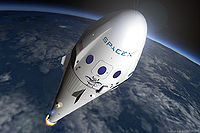Escape Velocity: Difference between revisions
Vrajagopal6 (talk | contribs) No edit summary |
Vrajagopal6 (talk | contribs) No edit summary |
||
| Line 19: | Line 19: | ||
:<math>(K + U_g)_i = (K + U_g)_f \,</math> | :<math>(K + U_g)_i = (K + U_g)_f \,</math> | ||
''K''<sub>''ƒ''</sub> = 0 because final velocity is zero, and ''U''<sub>gƒ</sub> = 0 because its final distance is infinity, | ''K''<sub>''ƒ''</sub> = 0 because final velocity is zero, and ''U''<sub>gƒ</sub> = 0 because its final distance is expressed as infinity, therefore | ||
:<math>\frac{1}{2}mv_e^2 + \frac{-GMm}{r} = 0 + 0</math> | :<math>\frac{1}{2}mv_e^2 + \frac{-GMm}{r} = 0 + 0</math> | ||
Revision as of 16:00, 5 December 2015
created by Varun Rajagopal

Escape velocity is defined as the minimum velocity required for an object to escape the gravitational force of a large object. The sum of an object's kinetic energy and its Gravitational potential energy is equal to zero. The gravitational potential energy is negative due to the fact that kinetic energy is always positive. The velocity of the object will be be zero at infinite distance from the centre of gravity. There is no net force on an object as it escapes and zero acceleration is perceived.
The Main Idea
The formula for escape velocity at a certain distance from a body is calculated by the formula Template:Cite book
- [math]\displaystyle{ v_e = \sqrt{\frac{2GM}{r}}, }[/math]
where G is the universal gravitational constant (G = 6.67×10−11 m3 kg−1 s−2), M is the mass of the large body to be escaped, and r the distance from the center of mass of the mass M to the object.<ref group="nb"> This equation assumes there is no atmospheric friction and is an ideal scenario with sending an object on a trajectory. In fact, the escape velocity stated here should actually be called escape speed due to the fact that the quantity to be calculated is completely independent of direction. Notice that the equation does not include the mass of the object escaping a large body as escape velocity is only dependent on gravitational force. We also assume that an object is escaping from a uniform body.
A Mathematical Model
When we model escape velocity or speed, we have to assume that an object must have a velocity an infinite distance away from a large body allowing us to find the very minimum speed to escape that large body a certain distance away.
- [math]\displaystyle{ (K + U_g)_i = (K + U_g)_f \, }[/math]
Kƒ = 0 because final velocity is zero, and Ugƒ = 0 because its final distance is expressed as infinity, therefore
- [math]\displaystyle{ \frac{1}{2}mv_e^2 + \frac{-GMm}{r} = 0 + 0 }[/math]
- [math]\displaystyle{ v_e = \sqrt{\frac{2GM}{r}} }[/math]
A Computational Model
How do we visualize or predict using this topic. Consider embedding some vpython code here Teach hands-on with GlowScript
Examples
Be sure to show all steps in your solution and include diagrams whenever possible
Simple
Middling
Difficult
Connectedness
- How is this topic connected to something that you are interested in?
- How is it connected to your major?
- Is there an interesting industrial application?
History
Put this idea in historical context. Give the reader the Who, What, When, Where, and Why.
See also
Are there related topics or categories in this wiki resource for the curious reader to explore? How does this topic fit into that context?
Further reading
Books, Articles or other print media on this topic
External links
References
This section contains the the references you used while writing this page